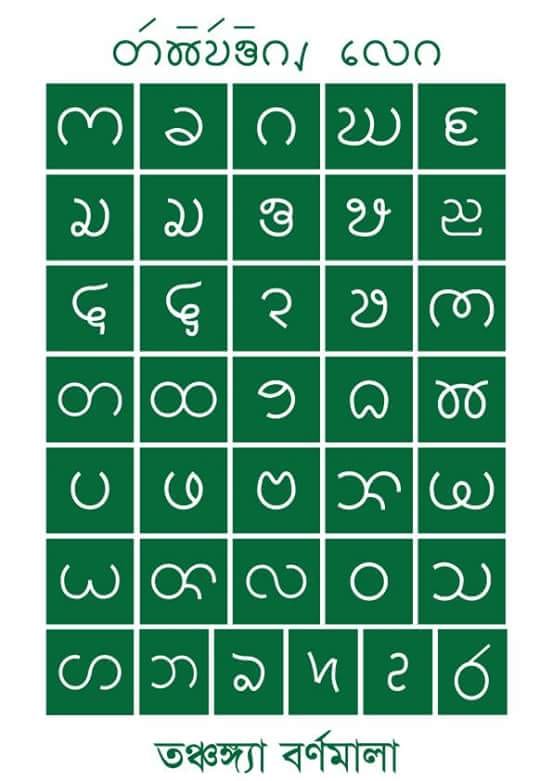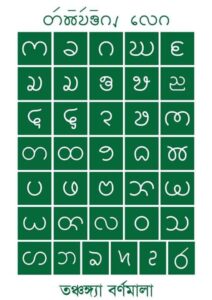
The Tanchangya alphabet, known as Ka-pat, is an abugida script used to write the Tanchangya language, primarily spoken by the Tanchangya community in the Chittagong Hill Tracts of Bangladesh and parts of Myanmar. This unique writing system belongs to the southern Brahmic family of scripts, sharing similarities with the Burmese, Mon, and Chakma alphabets. Understanding the Tanchangya alphabet offers insights into the cultural identity and linguistic heritage of the Tanchangya people.
Origins of the Tanchangya Alphabet
The Tanchangya alphabet was reintroduced in 2012, when a manuscript from Rakhine State was adopted for its creation (Rupak Debnath, 2008). Historically, both the Chakma and Tanchangya communities have utilized the Chakma alphabet for writing. However, the origins of these scripts remain somewhat ambiguous, with no definitive evidence indicating who originally developed them.
John M. Clifton, in his work “Dialects, Orthography and Society,” suggests that the Tanchangya community chose to base their alphabet on the Chakma script to emphasize their connection to the Chakma people. However, they also made systematic changes to the alphabet to assert their distinct identity within the broader Chakma community. This decision was crucial in fostering a unique cultural identity while avoiding misunderstandings between the two groups. Currently, the Tanchangya alphabet has not yet been developed into a Unicode font and exists as a True Font.
Writing System and Structure
The Tanchangya alphabet is written from left to right, similar to other Brahmi scripts, contrasting with Kharosti, which is written from right to left. This left-to-right orientation is characteristic of many South Asian scripts and facilitates ease of reading and writing.
Vowels
The Tanchangya alphabet features four independent vowels: A (a:), I (i), V (ʊ), and E (e). Additionally, there are five dependent vowels: Aa (ɔ), AA (ʌ), Ii (i:), and Uu (u:). This distinction between independent and dependent vowels is a common feature in abugida scripts, where vowel sounds are often integrated with consonants.
Consonants
The alphabet comprises thirty-one consonant letters, categorized into group consonants and miscellaneous consonants. This classification system reflects the phonetic structure of the Tanchangya language, allowing for a wide range of sounds to be represented in writing.
Historical Context and Development
The Tanchangya alphabet’s design appears to be derived from ancient Brahmic scripts, which typically incorporate vowel sounds within the consonants. If it is not an independent derivation, it likely has roots in the Burmese or Mon scripts, given the historical interactions between the Tanchangya people and these cultures. The Tanchangya community has resided alongside Mon and Burmese peoples since the 9th century BCE in Tagaung, an ancient civilization (G.C. Luce, 2008).
The Tanchangya people faced significant upheaval in the 14th century when they were attacked by the Rakhine king, leading to their relocation from Micchagiri (present-day Thayet in Magwe Division) to Arakan according to Rakhine Chronicle. This tumultuous history has influenced their cultural and linguistic development. It is believed that the Tanchangya used Brahmi scripts in their earlier stages, being referred to as Thek or Sakya in northern Myanmar.
Cultural Significance
The Tanchangya alphabet is more than just a writing system; it is a vital component of the Tanchangya cultural identity. By developing their own script, the Tanchangya people have created a means of preserving their language and heritage, fostering a sense of community and belonging. The introduction of the Tanchangya alphabet signifies a reclamation of identity and a commitment to cultural preservation in the face of historical challenges.
In conclusion, the Tanchangya alphabet stands as a testament to the resilience and creativity of the Tanchangya people. As they continue to develop and promote their writing system, they not only honor their past but also pave the way for future generations to connect with their rich cultural heritage. The Tanchangya alphabet is a symbol of identity, unity, and the ongoing journey of a community striving to maintain its linguistic and cultural uniqueness.
Work Cited
G.H. Luce (2008), The Glass Palace Chronicle of the Kings of Myanmar, Yangon: Unity Publishing House.
Debnath, Rupak (2008), Ethnographic Study of Tanchangya of CHT, CADC, South Tripura and Sittwe, Kolkata: Kreativmind.
Clifton, John M. (2008). “Dialects, Orthography and Society” (PDF). Work Papers of the Summer Institute of Linguistics. Retrieved 2015-11-20.




